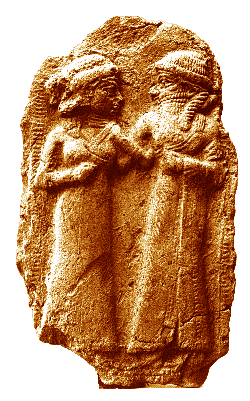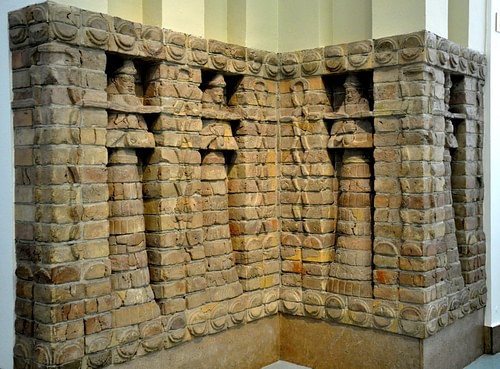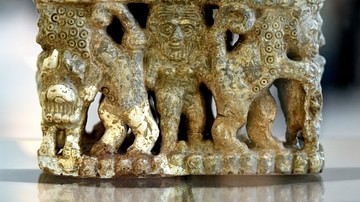
Inanna is the ancient Sumerian goddess of love, sensuality, fertility, procreation, and also of war. She later became identified by the Akkadians and Assyrians as the goddess Ishtar, and further with the Hittite Sauska, the Phoenician Astarte and the Greek Aphrodite, among many others.
She was also seen as the bright star of the morning and evening, Venus, and identified with the Roman goddess. Inanna is one of the candidates cited as the subject of the Burney Relief (better known as The Queen of the Night), a terracotta relief dating from the reign of Hammurabi of Babylon (1792-1750 BCE) although her sister Ereshkigal is the goddess most likely depicted.
In some myths she is the daughter of Enki, the god of wisdom, fresh water, magic and a number of other elements and aspects of life, while in others she appears as the daughter of Nanna, god of the moon and wisdom, but is most often depicted as the granddaughter of Enlil and niece of Enki. As the daughter of Nanna, she was the twin sister of the sun god Utu/Shamash and, in some poems (including Gilgamesh, Enkidu, and the Netherworld), she is the sister of the hero Gilgamesh. Her power and provocation is almost always a defining characteristic in any of the tales told of her.
Inanna in Myth
Through the work of the Akkadian poet and high priestess Enheduanna (l. 2285-2250 BCE), daughter of Sargon of Akkad (r. 2334-2279 BCE), Inanna was notably identified with Ishtar and rose in prominence from a local vegetative deity of the Sumerian people to the Queen of Heaven and the most popular goddess in all of Mesopotamia. Scholar Gwendolyn Leick writes:
Inanna was the foremost Sumerian goddess, patron deity of Uruk. Her name was written with a sign that represents a reed stalk tied into a loop at the top. This appears in the very earliest written texts from the mid-fourth millenium B.C. She is also mentioned in all the early god lists among the four main deities, along with Anu, Enki, and Enlil. In the royal inscriptions of the early Dynastic Period, Inanna is often invoked as the special protectress of kings. Sargon of Akkad claimed her support in battle and politics. It appears that it was during the third millenium that the goddess acquired martial aspects that may derive from a syncretism with the Semitic deity Ishtar. Inanna's main sanctuary was the Eanna (`House of Heaven') at Uruk, although she had temples or chapels in most cities. (89)
The goddess appears in many ancient Mesopotamian myths, most notably Inanna and the Huluppu-Tree (an early creation myth), Inanna and the God of Wisdom (in which she brings knowledge and culture to the city of Uruk after receiving the meh - gifts of civilization - from the god of wisdom, Enki, while he is drunk), The Courtship of Inanna and Dumuzi (the tale of Inanna's marriage to the vegetation-god), and the best known poem The Descent of Inanna (c. 1900-1600 BCE) in which the Queen of Heaven journeys to the underworld.
Besides these works and short hymns to Inanna, she is also known through the longer, more intricate hymns written by Enheduanna in honor of her personal goddess and the patroness of Uruk: Inninsagurra, Ninmesarra, and Inninmehusa, which translate as 'The Great-Hearted Mistress', The Exaltation of Inanna', and 'Goddess of the Fearsome Powers', all three powerful hymns which influenced generations of Mesopotamians in their understanding of the goddess and elevated her status from a local to a supreme deity. Inanna's personal ambition is attested to in a number of the works which feature her. Scholar Jeremy Black writes:
Violent and lusting after power, she stands beside her favourite kings as they fight. In a Sumerian poem, Inanna campaigns against Mount Egih. Her journey to Eridu to obtain the meh and her descent to the underworld are both described as intended to extend her power. (108)
This ambition can also be seen through her manipulation of Gilgamesh in the tale of the Huluppu Tree: when she cannot handle the problem of the pests which infest the tree, and fails to find help from her brother Utu/Shamash, she attracts the attention of Gilgamesh who takes care of the situation for her. Still, her stated intentions in this story are honest. She only wants to cultivate the tree in order to harvest the wood and cannot handle the serious and threatening pests which make it their home. Her gift of the magical objects (possibly a sacred drum and drum sticks) to Gilgamesh for helping her eventually result in his friend Enkidu's journey to the underworld to retrieve them (in Gilgamesh, Enkidu, and the Netherworld) and the description of the afterlife he brings back to Gilgamesh.

In the famous Sumerian/Babylonian poem The Epic of Gilgamesh (c. 2700 - 1400 BCE) Inanna appears as Ishtar and, in Phoenician mythology, as Astarte. In the Greek myth The Judgment of Paris, but also in other tales of the ancient Greeks, the goddess Aphrodite is traditionally associated with Inanna through her great beauty and sensuality. Inanna is always depicted as a young woman, never as mother or faithful wife, who is fully aware of her feminine power and confronts life boldly without fear of how she will be perceived by others, especially by men.
In The Epic of Gilgamesh, as Ishtar, she is seen as promiscuous, jealous, and spiteful. When she tries to seduce Gilgamesh, he lists her many other lovers who have all met with bad ends at her hands. Enraged at his rejection, she sends the husband of her sister Ereshkigal, Gugulana (the Bull of Heaven) to destroy Gilgamesh's realm. Gugulana is then killed by Enkidu, the best friend and comrade-in-arms of Gilgamesh, for which he is condemned by the gods to die. Enkidu's death is the catalyst for the famous quest Gilgamesh undertakes to discover the meaning of life. Inanna, then, is central to the story of one of the greatest of ancient epics.
Aspects of the Goddess
She is often shown in the company of a lion, denoting courage, and sometimes even riding the lion as a sign of her supremacy over the 'king of beasts'. In her aspect as goddess of war, Inanna is depicted in the armor of a male, in battle dress (statues frequently show her armed with a quiver and bow) and so is also identified with the Greek goddess Athena Nike. She has been further associated with the goddess Demeter as a fertility deity, and with Persephone as a dying-and-reviving god figure, no doubt a carry-over from her original incarnation as a rural goddess of agriculture.
Although some writers have claimed otherwise, Inanna was never seen as a Mother Goddess in the way that other deities, such as Ninhursag, were. Black notes:
One aspect of [Inanna's personality] is that of a goddess of love and sexual behaviour, but especially connected with extra-marital sex and - in a way which has not been fully researched - with prostitution. Inanna is not a goddess of marriage, nor is she a mother goddess. The so-called Sacred Marriage in which she participates carries no overtones of moral implication for human marriages. (108)
Rather, Inanna is an independent woman who does as she pleases, quite often without regard for consequences, and either manipulates, threatens, or tries to seduce others to fix the difficulties her behaviour creates. There are no poems, tales, or legends which in any way portray her differently and none which depict her in the role of the Mother Goddess.
In the Mesopotamian pantheon Inanna's geneology varies with the era of the myth and the tale told. She is the daughter of the supreme god Anu but also is depicted as the daughter of the moon-god Nanna and his consort Ningal. Alternately, she is the daughter of the god of wisdom Enki and sister to Ereshkigal (goddess of the underworld), twin sister of the sun god Utu/Shamash, and sister of Ishkur (also known as Adad), god of storms. She is also sometimes referenced as the daughter of the Supreme God of the Air, Enlil.
Her husband Dumuzi - who suffers for her rash choices in the poem The Descent of Inanna - transforms in time into the dying-and-reviving god Tammuz and, annually at the autumn equinox, the people would celebrate the sacred marriage rites of Inanna and Dumuzi (Ishtar and Tammuz) as he returned from the underworld to mate again with her, thus bringing the land to life. The Sacred Marriage of Inanna and Dumuzi was central to the fertility of the land and was re-enacted at important festivals (such as the Akitu Festival at Babylon) by the king and a priestess having sexual intercourse or, perhaps, only symbolically mating in a kind of pantomime.
Worship of Inanna
Her temple at Uruk was her central cult center but throughout Mesopotamia her temples and shrines were numerous and sacred prostitutes, of both genders, may have been employed to ensure the fertility of the earth and the continued prosperity of the communities. Her clergy were both male, female, and a third which one would define as "transgender" in the modern-day. Male transgenders, known as kurgarra, castrated themselves, females who identified as males were known as galatur; both were thought to have either been transformed by Inanna/Ishtar herself or created by the Father God Enki to rescue Inanna from the underworld. The Descent of Inanna notes that Enki made them "neither male nor female" and the clergy of Inanna's temple honored this tradition by embodying it. Scholar Colin Spencer comments:
Sacred prostiution was the central part of the ritual in the Temple. The priestess performed a sacred marriage to ensure the fertility of the country and the great fortune of the new king, for the king copulated with the holy priestess at the beginning of his reign. There were lesser priestesses who were also musicians, singers, and dancers, certainly some of these were men who also copulated with both men and women. The goddess Ishtar had turned these men into women as a demonstration of her awesome powers. Yet though Ishtar was an all-powerful presence and through prostitution was revered and was also an important economic factor in the running of the Temple, women's role in society began to be secondary to that of men. (29)
Inanna continued as a powerful and popular goddess until the decline of the prestige of female deities during the reign of Hammurabi which, according to scholar Samuel Noah Kramer, coincides with women's loss of status and rights in society. Still, as Ishtar of the Assyrians, she continued to be widely venerated and inspired the visions of similar deities in other cultures of the Near East and beyond.
The Enduring Goddess
Inanna is among the oldest deities whose names are recorded in ancient Sumer. She is listed among the earliest seven divine powers: Anu, Enlil, Enki, Ninhursag, Nanna, Utu, and Inanna. These seven would form the basis for many of the characteristics of the gods who followed. In the case of Inanna, as noted above, she would inspire similar deities in many other cultures.
A vastly different personality from that of the traditional Mother Goddess (as exemplified in Ninhursag), Inanna is a brash, independant young woman; impulsive and yet calculating, kind and at the same time careless with other's feelings or property or even their lives. Black writes:
The fact that in no tradition does Inanna have a permanent male spouse is closely linked to her role as the goddess of sexual love. Even Dumuzi, who is often described as her `lover', has a very ambiguous relationship with her and she is ultimately responsible for his death. (108)
The fact that the Sumerians could conceive of such a goddess speaks to their cultural value and understanding of femininity. In Sumerian culture, women were highly regarded and even a cursory survey of their pantheon shows a number of significant female deities such as Gula, Ninhursag, Nisaba, Nanshe, and Ninkasi, among many others. In time, however, these goddesses lost status to male deities.
Under the reign of the Amorite king Hammurabi of Babylon, goddesses were increasingly replaced by gods. Inanna kept her position and prestige through her adoption by the Assyrian and Neo-Assyrian empire as Ishtar, goddess of war and sex, but many others did not fare so well. Nisaba, formerly the scribe of the gods and patroness of the written word, was assimilated into the god Nabu under Hammurabi's reign and this was the fate of many others.
Inanna endured, however, because she was so accessible and recognizable. Women and men both could relate to this goddess and it was no coincidence that both sexes served her as priests, temple servants, and sacred prostitutes. Inanna made people want to serve her because of who she was, not what she had to offer, and her devotees remained faithful to her long after worship in her temples had ceased. She was closely associated with the morning and evening star and, even the present day, she continues to be through her link with Venus - even if few remember her by her Sumerian name.






